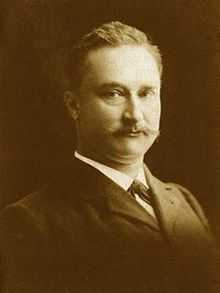Eugène Dubois

Marie Eugène François Thomas Dubois (28 January 1858 – 16 December 1940, pronunciation: [yʒɛndybwa] was a Dutch paleoanthropologist and geologist. He earned worldwide fame for his discovery of Pithecanthropus erectus (later redesignated Homo erectus), or "Java Man". Although hominid fossils had been found and studied before, Dubois was the first anthropologist to embark upon a purposeful search for them.
Life and work
Dubois was born and raised in the village of Eijsden, Limburg, where his father, Jean Dubois, was an apothecary, later the mayor. Interested in all phenomena of the world of nature, Eugène explored the "caves" ("grotten", actually underground limestone mines) of Mount Saint Peter and amassed collections of plant parts, stones, insects, shells, and animal skulls. From age 12-13 on, he attended school in the Limburg city of Roermond, boarding with a family there and then he dropped out. In Roermond he attended lectures on Charles Darwin's new theory of evolution given by the German biologist, Karl Vogt.
Resisting his father's plan for him to train to follow in his footsteps, Dubois, encouraged by his teachers, decided in 1877 to study medicine at the University of Amsterdam. While a student, he taught anatomy at both of the brand new (founded 1880) art schools housed at the Rijksmuseum Amsterdam (Amsterdam State Museum) the Rijksschool voor Kunstnijverheid (State School for Applied Arts) and the Rijksnormaalschool voor Teekenonderwijzers (State Normal School for Drawing Instructors).[1] In 1884 he completed his medical degree. He declined an offer from the University of Utrecht of a position as a docent. Instead, at the invitation of his anatomy instructor, Max Fürbringer, he decided to train as an academic. From 1881 to 1887 he studied comparative anatomy and became Fürbringer's assistant. In 1885 he investigated the larynx of vertebrates, which led him to develop a hypothesis of the evolution of this organ. Nevertheless, his chief interest was in human evolution, influenced by Ernst Haeckel, who reasoned that there must be intermediate species between ape and human.
Dubois contributed an article on whale anatomy to a book by the Dutch zoologist, Max Weber, and, inspired by the fresh discovery of new Neanderthal fossils at the Belgian town of Spy, he spent his vacation fossil hunting in the vicinity of his birthplace. In the Henkeput[2] near the village of Rijckholt, where a prehistoric flint mine had just been discovered in 1881, he found some prehistoric human skulls.
Reasoning that the origins of the human species must be in the tropics, in 1887 he joined the Dutch army and arranged to be posted in the Dutch East Indies (the Dutch colony that is now independent Indonesia), to the dismay of his academic colleagues. With his wife and newborn daughter he moved to the colony to search for the missing link in human evolution. (He was unalterably convinced there was only one missing link.)[3]
Hominid discoveries
Between 1887 and 1895, Dubois searched at potential sites near rivers and in caves, first on the island of Sumatra, then on the Indonesian island of Java.
In 1891, Dubois discovered remains of what he described as "a species in between humans and apes". He called his finds Pithecanthropus erectus ("ape-human that stands upright") or Java Man. Today, they are classified as Homo erectus ("human that stands upright").[4] These were the first specimens of early hominid remains to be found outside of Africa or Europe. During this period Dubois carried out fieldwork at sites such as Sangiran in Central Java and Trinil in East Java.
Later years
In 1897, the University of Amsterdam awarded Dubois an honorary doctorate in botany and zoology, but he had to wait until 1899 for a professorship. In that year, he was appointed a professor in geology, a function that did not keep him from his research in anatomy. He was also (from 1897 until 1928) keeper of paleontology, geology and mineralogy at Teylers Museum,[5] where he also kept the H. erectus remains.
Although the scientific debate slowly began to turn in his favour in the 1920s and 1930s, he died embittered in 1940. He was buried in Venlo.
His paleontological collection and scientific archive remain at Naturalis in Leiden.[6]
See also
| Wikimedia Commons has media related to Eugène Dubois. |
- List of fossil sites (with link directory)
- List of hominina (hominid) fossils (with images)
Notes
- ↑ "Rijksmuseum Research Library - online-catalogue". euromuse.net. Retrieved 2014-06-15.
- ↑ "Summary: Prehistorical flint-mining in the Netherlands: Rijckholt (Ryckholt) - St. Geertruid". Vuursteenmijnen.nl. Retrieved 2014-06-15.
- ↑ Morwood and van Oosterzee 2007: 124
- ↑
- ↑ In this position, he was the successor to Tiberius Cornelis Winkler, who was one of the earliest translators (1860) of Charles Darwin's Origin of Species and a very early proponent of human evolution.
- ↑ de Vos, J. (2004). "The Dubois collection: a new look at an old collection" (PDF). Scripta Geologica Special Issue 4 p. 267-285.
References
- Morwood, Mike, and van Oosterzee, Penny. 2007. A new human: the startling discovery and strange story of the "hobbits" of Flores, Indonesia. Smithsonian Books.
Further reading
- Pat Shipman, The Man who Found the Missing Link. Eugène Dubois and His Lifelong Quest to Prove Darwin Right, Harvard University Press (April 30, 2002), 528 pages, ISBN 0-674-00866-9.
External links
- (Dutch) DUBOIS - The Quest for the Missing Link, www.eugenedubois.eu
- Biographies: Eugene Dubois at TalkOrigins Archive
- http://www.cryingvoice.com/Evolution/ApeMen2.html
- Fossil Hominids, Human Evolution: Thomas Huxley & Eugene Dubois at www.understandingevolution.org
|